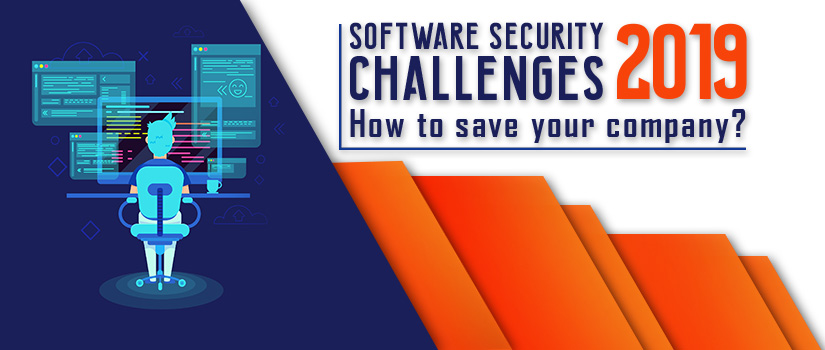The recent years have seen probably the most continuous and extreme software security attacks ever recorded against organizations in an assortment of enterprises.
Security — once only a little piece of big IT enterprise — is presently a vast range, critical for business achievement. It has lifted the purpose of safety and risk the management leaders who are currently facing the troublesome task of shielding their company from destructive cyber attacks and stricter regulators with raised aspirations.
Here’s a list of the leading software security threats we suspect in 2020 and how your company can ensure itself.
Ransomware and IoT
An ever-growing number of hackers seem to have driven their consideration to ransomware. Ransomware acts as it relies on users’ careless security actions.
A huge percentage of internet users do not comprehend best methods – It is likely that most cyber criminals are adapting to it for their source of income. We ought not to underestimate the possible harm IoT ransomware might cause in 2019.
For instance, cyber criminals may target severe arrangements like the city energy grids. If the target city declines or fails to pay the ransom timely, the attackers can totally seal down the energy grid.
Subsequently, as several towns and houses are choosing smart technology in 2018 and 2019, hackers can attack smart cars, factory production, home appliances like smart fridges, TVs, ovens and much more.
So, we should at present be extremely mindful to not to undervalue the potential damage IoT ransomware could cause to us in 2019. And, in 2020, we hope to see more companies thinking of ransomware reimbursement methodologies and keeping information in different, imitated areas.
Artificial Intelligence Gags the Internet
Artificial Intelligence is considered a potential danger which is not too far off.
Know More : Major Cyber Attacks in India (2018)
AI gets more refined, and we depend on the code to write code, thus, we can lose the capacity to track and regulate it.
The CIO investigation raises the dangers of AI mechanizing complex systems and acquiring from wrong or deficient data, prompting erroneous ends.
While security and QA experts get Artificial Intelligence to battle on their side, the hackers will utilize AI further in their favor as well.
Moreover, down in the spiral of murkiness, risk factors may weaponize AI devastating administration delivery and the Internet of Things (IoT), and making governments separate Internet landscape in protection. People can be pushed off the Internet, with odd results.
In the year 2020, smart administrations will have the capacity to locate the shortest framework vulnerabilities and break down complex client behavior situations, performing troublesome estimations which take a very long time for an expert human programmer to direct.
Software Update Supply Chain Attack
The software update supply chain attacks are an imminent digital risk. This sort of attack embeds a part of malware into a generally authorized software package at its standard delivery area.
It happens amid the development phase of the product seller, at a third-party storage area or by redirection.
One reason for this attack is the number of infections, infused when updating product, can develop unnoticed and rapidly. Cyber-criminals frequently target specific divisions or areas.
In 2020, companies should concentrate on the weakest points in their product update supply chains. Few out of every odd security attack can be counteracted early, if not all, yet your providers and on-site digital security professionals should be proactive in any case.

Embrace powerful, repeatable, and adaptable procedures with convictions that are corresponding to the dangers you confront. Companies should install supply chain data risk management in the current recovery and vendor management processes.
Organizations Will Sink to Comply to the GDPR
The GDPR – General Data Protection Regulation that became effective in May 2018 provides various imperative changes to the present Data Protection Directive. These incorporate – stricter consent laws, expanded the regional scope and raised rights for data subjects to give some examples.
With GDPR, entrepreneurs can’t stand to overlook security anymore. As for international organizations which fail to comply with this resolution, penalties for non-compliance can touch up to 4% of global annual turnover.
For software testers and engineers, this exhibits a major test. Checking the security of data handling and storage, database testing, and adding cookies — these are only a couple of motives for the developer nowadays.
GDPR made the whole stuff harder for both developers and entrepreneurs as well as marketing divisions. Then again, the direction could be the enormous impact that will drive organizations to at long last think about security as their principle need.
Security Moves to the Cloud
Enterprise security groups are getting inundated under the maintenance weight of legacy security services. Cloud-based security software is more flexible and can execute new recognition strategies and solutions quicker than on on-site systems.
However, not every cloud security solution is an equivalent.Foes go where the gold is, and 2020 pledges to contribute a growing number of events for attackers in the cloud system. With the cloud, there’s a unique, and usually growing attack surface which can be left exposed or with inaccurate protection in place to secure valuable data.
Exploiting the cloud is more substantial than stimulating legacy management servers to the cloud. SRM pioneers ought to search for arrangements that take full benefit of cloud scale, staff optimization, increased data telemetry, API-based access, machine learning, and different products and services that are troublesome to the norm.
Botnets DDOS Attacks
Botnets are incredible systems of arbitrated machines that can be remotely managed and used to dispatch attacks on a gigantic scale, once in a while including a considerable number of Zombie PCs.
Know More : Harmful Browser Security Threats: How to Avoid Them?
Botnets are led by Command and Control (C&C) networks, which are controlled by the cybercriminals. They can be utilized to dispatch attacks called DDOS (Distributed Denial of Service), to make an objective site so busy that it cannot process right requests.
DDOS attacks are even capable to totally crash the targeted webpage, and support might be offered just if the objective site proprietor pays a ransom amount to hackers.
Botnets can likewise be utilized to attack secure frameworks, with every bot working at a frequency of low attack to dodge detection, yet the total playing out an extensive brute-force attack.
The principal watchdog against botnets is to shield your machines from getting to be a botnet, by applying strategies for limiting infection from viruses and worms, along with the use of antivirus software and keeping the software updated.
However, even though all the machines in your business are kept clean, you can be attacked when third-party machines are regulated to attack your infrastructure or web server. In view of the scale, resistance for this situation demands a collaborative methodology incorporating working with your ISP, law enforcement agencies, and system software vendors.
Container Adoption
The notoriety of software container systems, for example, Docker have detonated in recent few years as organizations search for approaches to let applications run reasonably when shifted from one environment onto the next. With a container, every application or process on a server gets its own environment to drive that shares the operating system of the host server.
Since containers don’t need to load an OS, they can be made immediately. They are furthermore movable, simple to scale and separate complex applications into modular micro services.
In any case, similar components that empower containers to build agility additionally lead to security challenges. The utilization of a shared OS model implies a vulnerability attack in the host OS which could prompt a compromise for every container.
Since containers can be made right away, it is basically incomprehensible for conventional network and endpoint controls to stay aware of the progressions required to anchor them.
They make another attack surface through the APIs and command plane, which present intricacy in conveying the real assessment setting, imperiling application internals.
Security members should know about container deployments that are in process in the company. A persistent vulnerability appraisal and remediation plan is an essential part of productive containerization activities.
Also, container security suppliers offer tools for companies which give full life cycle vulnerability management and application-customized run time security to help guard containers against dangers.
What Can You Do to Prevent Your Enterprise from Cyber Security Attacks in 2020?
A particular breach can lead to huge losses, both regarding the company reputation and money.Though cyber threats and risks proceed to stack up, the good news is – the difficulties we are about to encounter in 2020 aren’t unbeatable.
The solution is to take immediate,careful actions. Prevention from the increasing number of threats and attacks hitting you in 2020 begins with instructing workers, utilizing versatile up-to-date cyber security systems and solution, and obtaining knowledge into the dangers focusing on your industry or business. These needs are a significant challenge for cybersecurity administrators.

Seek assistance from a software security testing company so that your systems can be thoroughly monitored.
As the security experts get ready for another likely record-breaking year of data security threats and network breaches, so, it is crucial that you make yourself attentive of the most recent digital security technologies and methods to remain one step ahead of the culprits and ensure your most vital resources.
